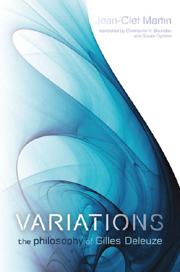Book contents
- Frontmatter
- Contents
- Letter-Preface by Gilles Deleuze
- Preambles
- First Variation: Ethics and Aesthetics
- Second Variation: Three Poetic Formulas for Nomadic Distribution
- Third Variation: Multiplicities
- 1 The Image of Thought
- 2 Variations
- 3 Poetics of Multiplicities
- Fourth Variation: Malcolm Lowry, or, the Manifesto of Things
- Postscript to the Anglo-American Edition: What is a Multiplicity?
- Notes
- Bibliography
- Index
1 - The Image of Thought
from Third Variation: Multiplicities
Published online by Cambridge University Press: 12 September 2012
- Frontmatter
- Contents
- Letter-Preface by Gilles Deleuze
- Preambles
- First Variation: Ethics and Aesthetics
- Second Variation: Three Poetic Formulas for Nomadic Distribution
- Third Variation: Multiplicities
- 1 The Image of Thought
- 2 Variations
- 3 Poetics of Multiplicities
- Fourth Variation: Malcolm Lowry, or, the Manifesto of Things
- Postscript to the Anglo-American Edition: What is a Multiplicity?
- Notes
- Bibliography
- Index
Summary
Rembrandt, Philosopher in Meditation, Amsterdam, 1631. Emerging from a pitch-black wall, a half-open window admits the diffusion of an uncertain glow. We can see nothing beyond the window. And yet, coming from it there is plenty of light, ample incandescence, illumination, a whole world of fires and glowing embers – a diaphanous and yet impenetrable burst of universal light reflected on a white façade. Here, in the hollow of this artificial opening, the eye witnesses something brilliant, each particle of which explodes in the vicinity of all the others. In the centre of the room, a flight of stairs unfurls its shell-like helix in silence. Positioned between the intangible light and the spiral staircase that carves out the space of the ascending steps, the philosopher composes himself – folded hands resting on legs covered by his dimly lit coat. We do not know whether this person is dozing or lost in thought. Could he, perhaps, be contentedly fixated on the wrinkled lines leading from one hand to the other over his interlaced fingers? Or, perhaps, with unfocused eyes, he is absorbed by any point whatever on the intersecting slabs of the floor. At any rate, the angle of his head reflects a redistribution of shade and light upon his face that exactly mirrors those chiaroscuro areas that shape the curve of the staircase. From bottom to top, towards the vaulted summit of this peaceful room, a crack contorts the visible space. Its S-shape arabesque unfolds as it exhausts the entire spectrum of light that diagonally expands.
- Type
- Chapter
- Information
- VariationsThe Philosophy of Gilles Deleuze, pp. 121 - 145Publisher: Edinburgh University PressPrint publication year: 2010

